Canned and preserved foods are found in the pantries of most preppers. And they have also been popular when packing for survival.
However, there are a couple of drawbacks to using canned foods for survival kits.
One is their size and bulk, taking up a lot of room. That utilizes significant space and energy when packing and traveling with that kit.
Another issue is that once opened, canned items need to be consumed rather quickly before going bad, especially if you don’t have access to refrigeration.
That will lead to consuming larger than desired amounts of the same item in a short period, or a lot goes to waste.
A great alternative to canned and preserved foods is MRE packs (Meal ready to eat). They are compact and often lightweight, making it much easier to store, as well as pack and carry.
And the long shelf life doesn’t end, just because you open the main package. I say “the main package”, because a homemade MRE will typically consist of a lot of small packages within a large one.
Because of all this and that they are easy to prepare, MREs are used not just by preppers, but also by federal disaster agencies and military.
Choosing Items for Your MREs
One thing to consider is nutrients. Make sure to put a balance of proteins and carbs in each bag. You will want both to sustain you throughout the day.
If your pack is for one meal, the goal should be around 1,000 calories. That might sound like a lot of calories, but if you are in survival mode, you could burn through those quickly. Remember, if you pack it right, you can easily save what you don’t eat, for later.
Another consideration is shelf life. Pick items that are known to last a long time before opening. Now, each bag can be for 1 meal or 1 day.
So, no need to worry too much about it having a long shelf life after opening. Just make sure nothing requires refrigeration.
Preparation is also key in choosing foods to put in your MRE. You won’t want to put in items that need to be cooked. You might get lucky and have the ability to cook over a campfire. But don’t bank on it.
So ready to eat foods are the best options. Some foods taste better when warm, but don’t necessarily require cooking. Those foods are fine to put in the pack.
Other than the above, it will come down to your own personal taste, but here are a few options to consider when making your own homemade MREs:
- Instant Ramen Noodles – A pack is lightweight, there is a variety of flavors and only require water.
- Instant Oats – They are a great source of fiber, and only require water
- Jerky – Good source of protein and flavor. Some jerky can be expensive. A less expensive alternative is Slim Jim sticks, which are individually wrapped (another perk!).
- Dried Fruits – Raisins and other dried fruits such as cranberries, cherries, and blueberries are nutritious and add a punch of flavor.
- Crackers – These make a good filler by adding calories, and can be a nice replacement to bread for other foods.
- Tuna – Small packages of tuna are lightweight, have a long shelf life, are easy to eat, and represent a great source of protein.
- Granola or Energy Bars – Easy to eat and great for adding fiber, nutrients, and protein. There is also no preparation required.
- Candy – If you like sweets, add a pack of M&M’s, Skittles, or a candy bar. This is not meant to replace an energy bar, but to satiate a sweet tooth. The added boost of sugar could be a good thing as well. Just make sure this is just a small addition.
- Seasonings and Condiments – Add small packets of seasonings, such as salt, pepper, or sweetener, as well as packets of condiments that you can save from a meal out. They are easy to pack and can add some flavor to your meal.
- Dried Instant Beverages – Instant coffee, dried milk, tea bags, and powdered protein shakes can all be added in small packets; they only require water.
You can consider other prepared items from the store that have a decent shelflife, such as Hormel ready to eat meals. Just take the pack out of the outer box to save room.
Homemade items are a great option if you have time to prepare them. Here are a few good ideas that will add a good balance of calories and proteins, as well as nutrients for survival:
- High-Calorie Ration Bars (our step by step recipe & pictures here)
- Dried Plums or other Fruits (our step by step recipe & pictures here)
- Bean and Rice Soup Mix (our step by step recipe & pictures here)
- Matzo Bread or Hardtack (our step by step recipe & pictures here)
- Dried Meats, such as Jerky or Pemmican (our step by step recipe & pictures: for Pemmican here and for Jerky here)
There are non-edible items to consider throwing into your MRE, so they are readily available to use each time you open a pack.
I would consider throwing in the following if it would help with the other items in your pack:
- Matches (our step by step guide with pictures here)
- Wet wipes
- A utensil
Get creative with your choices, because there are many options.
Putting Your MREs Together
Group the items you choose in a manner that provides a complete meal, keeping in mind it should be at least 1,000 calories for a survival situation, and be a good mix of carbs, protein, and vitamins/minerals. Make each pack a little different, so your meals won’t be the same.
Also, note the expiration dates, keeping them similar in each pack.
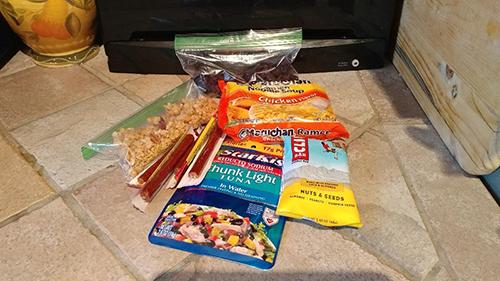
Place each MRE grouping into a plastic bag that can be used with a vacuum sealer. The sealer not only helps with freshness but also space. Speaking of space, some pre-packaged items, such as instant ramen, should be pierced slightly to let the air out before vacuum sealing. However, doing that with a tuna pack would be messy.
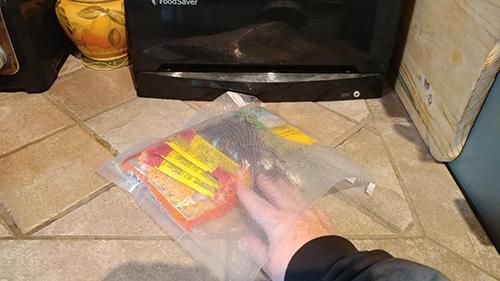
You can make notes on the outside of the package with a marker, such as the date it was packed, the seasonings in the pack, calorie count, and whatever other information you would find helpful.
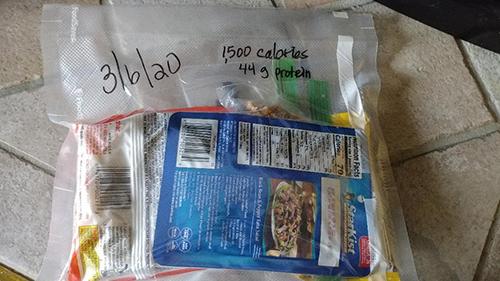
In addition to the MREs I prepared above, I also prepared 2 more that could be for breakfast and lunch, with simple products that I either had in my pantry or quickly threw into my basket at the market. I marked the date I put them together, as well as the number of calories and protein in each pack.
Breakfast: 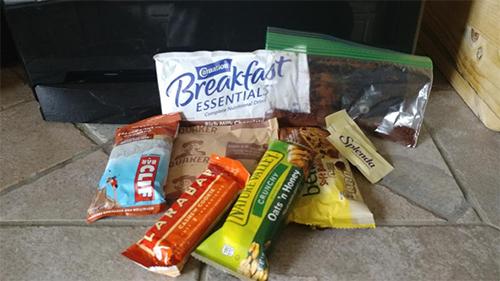
Lunch:
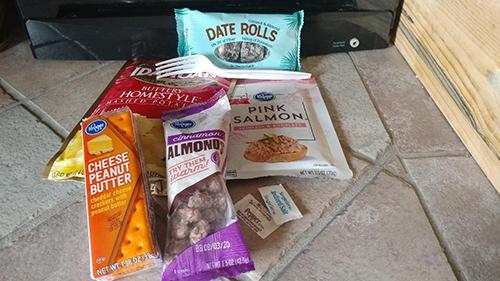
To sum up, vacuum sealing your MREs will help keep them fresher. It will also make it more compact for easier storage. Just make sure to choose ingredients that will have at least 6 months to a year’s shelf life. If they are approaching the expiration date, open and enjoy, rather than waste them. Then, make new packages to be prepared at all times.
You may also like:
 How to Make And Can Vienna Sausages (2 Years Shelf Life)
How to Make And Can Vienna Sausages (2 Years Shelf Life)
The U.S. Army’s Forgotten Food Miracle (Video)
8 Items You Need To Bring if You Need To Leave In 10 Minutes

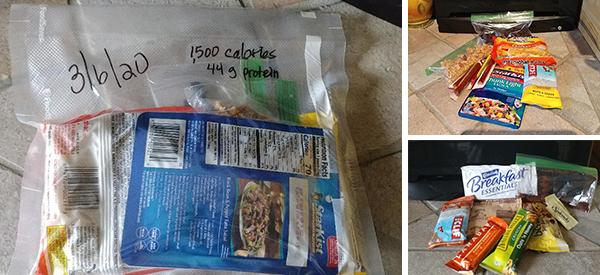













I was born in Scotland and I was brought up in Northern BC in Canada, and I then came back to Scotland. I know some of the things that he is talking about. We had an underground shelter which was our Ice house, and that was where we kept our food. We put blocks of Ice from the lake in there.
OUTSTANDING IDEAS here K.J. Barber. These are GREAT Ideas for hikes, school lunches, Pack-up and Git type scenarios, Emergencies, Stuck in Traffic, Hunting trips, or broke down/stuck, way, way out past back of beyond (Fond of Four wheeling in Southeast Utah, and Arizona). We do something like this same concept similar ingredients. We usually have a small Dutch oven, and/or aluminum foil with us. An EXCELLENT IDEA for these particular times, indeed.
THANK YOU!
Don’t forget toilet paper…..
C-Rations always had a little pack of toilet paper. They also contained a half a pack of cigarettes. I often wondered when folks were busy suing the tobacco companies for not telling them that cigarettes were bad for humans (I don’t know what rock they lived under, when I was a kid we all called them coffin nails) that men who had been in the service didn’t sue the government for facilitating their smoking habit by providing cigarettes in C-Rations and selling them dirt cheap in PXs and Ships Stores. A buck a carton in all the PXs I was ever in. Overseas we had cigarette ration cards to cut down on the black market sales. Ha Ha Ha lot of good that did.
I did this a few weeks ago for my two cars…I have 3 meals, for 3 days in each of my cars along with 3 days of food for my pets. Plus water, electrolytes, plastic utensils, can opener, blanket, matches, flashlights and some first aid.
I learned a couple of years ago, if I have to evacuate quickly, I will not have time to grab food.
With all this unexpected down time, I am consolidating where all my things I would want and/or need in one area, along with prioritizing them. And, Always keeping pet carriers and leashes in house and not garage. Keeping medications along with a bag so in one sweep of the arm, I will have them ready to go. Same with imp. Docs and weapons. All in one place, ready to load up if need be.
When we had to pack to possibly evacuate for the fires, I had to go room to room with my flashlight…that won’t be necessary anymore. Plus I bought a battery operated transistor radio so if the power goes out, I can hear news in house and not sit in car.
I also include a woman’s urinal jar in the trunk all the time. While I might not mind standing by the side of the road to relieve myself, I know that my wife certainly minds. In SoCal it is not always possible to find a large bush if one is stuck on an interstate highway. (I try to not call them freeways as there is nothing free about the taxes we pay that allegedly are spent on roads). It is not all that unusual unfortunately, to be stuck on a major highway without being able to exit for considerable periods of time. With the past year about 30 miles from here folks were stuck on the road for at least 10 hours and in the back of my mind I think it was more like 18 for some of them. Someone the cops had been chasing decided to engage in a standoff rather than surrender. I don’t remember how it ended, but it does point out how just an ordinary drive to the shopping mall might turn into an all day ordeal stuck in your car.
I also learned in packing to evacuate for the Thomas Fire that a headlamp is much better than holding a flashlight in your mouth so that you can use both hands to pack. In addition to being a drag, it makes communication with others difficult. With a headlamp I can talk and still use both hands. I don’t store my big lanterns for full room illumination with the batteries in them.
I used to store my 6 cell Maglite with the batteries in it for years and never had a bit of trouble with them leaking. Recently, however, I have had at least four battery operated devices ruined by Duracel batteries leaking and corroding the electrodes. My unscientific opinion is that LEDs draw so little current that it is possible for them to draw down the batteries much further than the old incadescent lights. I always knew when the batteries in my Maglite were dying as the light faded away dramatically. With the LED lights, if you don’t check the light against a similar flashlight it is difficult to tel if the light is dimming.
As a result of not storing the batteries in the area lanterns, they were not available for use in the time I felt I had to evacuate our home. Hence, using the flashlight-in-the-mouth technique for illumination.
Yup…
LCC,
That is some good advice right there. Talking about the lady’s urinal jar…
Always plan ahead for your girl’s dignity and comfort if possible — there is no better investment unless it involves God. lol
even in the mid 70’s Camels were $2.50 a carton in the state-side PX….. and they had flavor as memory serves. Funny how no one mentions the relaxing/calming benefits of tobacco therapy….. but they tout the studies and benefits of cannabis ….
Chuck don’t forget flavor packs to make all things edible !
Yeah, but in the 50s they were a buck a pack, a dollar a carton overseas. I understand that 98% of the doctors who switched to Camels eventually switched back to automobiles.
Sorry, that is a really old joke. Camel cigarettes used to advertise how many doctors had switched to Camel cigarettes.
I’d walk a mile for a Camel, but a miss is as good as a mile…?
PB: No, but they sure recommend nicotine patches. Any study done in the US or UK on tobacco is considered bogus. No other nations makes claims against tobacco. I heard that from doctors,and from family that had been SS, Hitler claimed it causes cancer (he got sick on just the smell of the smoke; anything Native American he despised) and both the UK Labour Party and the DNC took that stance. Nic calms, is non-addictive, and heals. If tobacco were bad, no totalitarian state would allow it. Instead, they keep the price low. Dems were whining that we were going into Mexico to buy tobacco. It was less than 5% the US cost, and the quality higher. The PRI raised the price of a pack to 10 bucks. Some bros brought me a carton of Faros and a couple of liters of la Reserve tequila a few years ago.a cousin makes his own 🙂 Drink at your own risk, catches fire on contact with air. niio
Small packs of handi-wipes, peanut butter (which comes in individual servings), trail mix, hard tack, dry cereal, dried banana chips, pemmican, dried soups…
Many of these things can be found at Dollar Tree in individual servings, but unfortunately they do tend to leave a lot of air in the bags.
Repack them in ziplock bags squeezing the air out as you seal it. If the contents are not too powdery, you can use a straw to draw out the air. Insert the straw at one end of the opening. Zip most the opening closed, leaving just the area where the straw is inserted open. Suck as much of the air out as you can. keep sucking as you extract the straw and pinch the open portion closed. It won’t be the equal of your home vacuum sealer, but it will take out most of the air and reduce the volume of the bag. Helps to use the smallest bag possible that will hold the goods or split it between two small bags.
If it is something that can stand rolling up in the bag, roll the bag with the hot dog inside and when the hot dog is at the opening, zip it shut. Again, not home vacuum sealer quality, but reduces volume in your bug out bag.
I just use a small hypodermic needle to suck down the air, and I seal them with a bit of super glue. use baking soda to make the glue harden immediately. This way they remain in the original packaging.
The super glue with baking soda works for many things, such as fixing nicked drone propellers better than new.
Another example… If you have a bubble in fiberglass. dig out the bad spot in the fiberglass, fill the hole with super glue, let it soak in and then dump on the baking soda. It cures instantly and it is harder than super glue alone.
Good, thank you. niio
You may want to carb-up for the big race, or to run your bicycle powered generator or washer…..
Cliff Bars, Larabars, (most Powerbar type) have very short shelf life. They will become moldy after 6 months, even when vacuum sealed. Cheese Crackers go stale in about 6 months also. I know cuz I did this very thing several times over the years. (I do believe ‘HooAh Bars” have a long shelf life but I’ve never tried one. Reviews are good though. I have no affiliation.)
My trick is to Vac-Pack everything but the PowerBars, I keep those in the freezer until I leave for my trip or hike, then grab a couple and throw them in my pack.
As for T.P. , I just put those pocket/purse size tissue packs in a freezer weight sandwich size zip-lock baggie (with the zipper open to allow the main bag better vacuum sealing) in each meal. seams to work for me.
My only real problem with store bought power bars is that they seem to have a lot of sugar in them. That is why I never even consider them as an emergency ration. Sugar is good for a quick energy boost, but then you get the sugar crash later. Not a good trade off for me.
A tienda down the valley carries dried beef and shredded carne asado (beef cooked, shredded and dried). The dried beef should be soaked to make jerky, then slow roasted to dry. Both are good for snacks and storage. niio
I use those compressed towels you can get on Amazon. They are great for a lot of things including wiping your butt. Ever been in a toilet stall and didnt look before you sat down to see if there was any TP? During this “pandemic” I have been in Wal Mart at least twice when the :urge” hit and had to go but n o TP in the stall. Apparently people were not only hoarding regular TP but also stealing the big rolls from the rest rooms. I have had that happen twice now as I said. I carry a small round aluminum pill carrier or vial that holds about 4 or 5 of the compressed trowe ls and its on my key chain so I KNOW I will have it when I need it. But I also have several bottles stashed in the truck, the bug out bag and elsewhere in case its needed. To use them you just apply a drop of water to the compressed towel and it starts to open and you just finish opening it and use it how you want. Its about as big as sheet of paper. You can also use old pill bottles or anything that seals fairly tight. Though I have yet to have one “activate” all by itself its best to keep them dry. Some come individually wrapped but I like the unwrapped kind. You can also find larger ones on Amazon too as well as in the Dollar Tree. Those are for kids mainly as they have super hero’s on thm but they still work great.
Rucksack Rob: I found these amazing TP “pills”! (from a post here, actually, didn’t know they existed until I read it here)
They are actually ‘re-usable’ cotton washcloths, that can be used for many things, including TP. They will biodegrade in a few days. You can pack about 10 of them in a small tube. I got a large container of them and have them in my car, purse (actually a backpack; I don’t carry a purse) and in my preps.
Amazing little things!
I have lived very low carb for 30 years and consider it a keystone to good health. Truth be told, Keto is not a good idea for long term food storage, it’s too challenging and expensive to store that much protein (unless you’re a crazy off grid friend of mine living in the Alaskan bush who shoots a couple of elk in the fall and lives in a giant deep freeze and has a winter’s worth of protein for the family that easily), long term survival in a post SHTF world is going to be based on rice and beans. But you can make a MRE type package that is low carb, all the stores have Atkins Diet and other brands and types of low carb snack packs.
Mike: Carnosine, the enzyme found in meat, is what fuels meat eaters. You’re right avoid carbs. They give a burst of energy, but need to constantly be recharged. Meat, especially red meat, lasts for hours. Have you made any pemmican? Chorizos cooked and dried are good, too, and with the chilis, resist insects for long term storage. You like beef (yi-haw! 🙂 buy a canner and make jerky and sausages. You can usually get one half the price of a yearling ready to slaughter. Pemmican is the ultimate MRE. Meat, fat, fruit, some veggies. And kept in smoke, it lasts for years. Just save any fat that escapes. Smoked fat used to cost more than good butter. niio
Chorizo!
Do you make the old Southwestern style of Tinga, cover the meat in whole chiles pequines and slow roast in a Dutch oven? Don’t know if it preserves or not cause I eat it up too fast. Hot, but nothing like it.
Carne asada! No, I make sausages with cider vinegar, which helps preserve it. Any chopped or ground meat is good with this.
Chorizos
Ingredients
1 pound ground pork (preferably pork butt)
1/2 cup cider vinegar
1 tablespoon coarse (kosher) salt
1 tablespoon minced garlic
1-1/2 tablespoons good-quality chili powder
1-1/2 tablespoons ground cumin
x
Instructions
Place the ground pork in a glass or ceramic bowl. Add the cider vinegar and coarse salt, cover, and refrigerate overnight. Add the garlic, chili powder, and cumin to the pork, and stir well. Let the mixture marinate 1 hour more.
and this is a good one, as well when smoked-dried.
https://www.meatsandsausages.com/sausage-recipes/fresh/mexican/chorizo-verde
I still say pemmican is te best. We like a lot of dried fruit in it. chiltepin, poblamo, jalapeno 🙂
You’re my mind of man, you think of peppers as fruit.
But they are a fruit! As well as rodent and insect repellent.
red:
I also have to do low carb as I’m diabetic. I can adjust the items here to accommodate myself, and recently bought a freeze dryer to freeze dry my own organic meats.
Never thought about Atkins stuff, but are they sugar free?
At Dollar General and Walmart, and elsewhere, they have these little bowls of Dinty Moore stew, Chicken breast and mashed potatoes, and others that I haven’t tried. Normally, you remove the cardboard sleeve/wrap, peel back the plastic a little to vent steam out of the bowl, and nuke them them for 1 minute. Very delicious, BUT, who wants to carry a microwave to heat them up? Of course that’s impossible. But, when I was in the Army (weekend warrior), our meals were served to us out in the field in big kettles that were heated, and cans of spaghetti and meatballs and others that I forgot, were fished out with a ladle and handed to us, steaming hot.
So, what I’m saying is, if you have a small pan, kettle, etc. that can hold these bowls with some water, you can heat them up by or over the fire till the water just starts to boil, then fish it out, and after a little cool down, peel back the plastic lid/wrapper and eat.
On the matter of toileting in the woods, a thought struck me some time ago. I was reading about the early Roman baths and public toilets in an article. The commode was positioned over a channel of running water, wherein you did your business. A stick with a sponge attached was used to wash and clean your bottom, then dipped into the running water to clean it off for the next person. Details were a little vague about how the sponge was cleaned, but I certainly hope it was a little sanitary.
So, I checked out some sponges on a stick at Dollar Tree and WalMart, and found some that could be used. One of the sponges was more of a ball shape, rather than the other style where strips of sponge were united at the center into the business end of the handle. I didn’t think that would make a good one.
Anyway, that’s some thoughts I had. I’m sure there are better ones out there. Thanks everyone!…………………gf
It is my understanding that in England in the public toilets a stick was provided for the purpose under discussion leading to the frequent cry after dark of having gotten the “mooky end of the stick” which has carried down to the present day with the comment about which end of the stick someone has ended up with.
Many cultures use soap and a rag for the cleansing under discussion. The rag can be washed out. When my kids were still in diapers long long ago and far far away, everyone used cloth diapers. The wealthy folks used diaper services which washed the soiled diapers and delivered them back to the house. Folks of more modest means (wife and I) rinsed the diaper out in the toilet and it went into the diaper pail until there was a washing machine load and then they were washed in the washing machine with soap and bleach and hung on the line to dry. If it was raining they went on a clothes drying rack inside the kitchen or wherever there was room.
Now that, Chuck, was SO interesting what you said about the “mooky stick” and getting the wrong end of it. We have so many expressions in our language that we utter, never really knowing sometimes what it really means and where it came from. I shared that with my wife and mom, and we all had a good laugh about it. Thanks for sharing that!…………………gf
Nemo: Most people used the pigpen, but any livestock will do. Don’t forget, Romans also suffered a lot of plagues. An outhouse isn’t that big a deal and in general sanitary. Just keep it 100 feet from any source of water. If you have black soldier flies (AKA outhouse flies) that a major plus. Adults have no mouth parts,the grubs sterilize what they eat, and they’ll eat almost anything, even that ah, unwanted guest that tries to raid you after SHTF. We want to put in a composting toilet. We know how to build one, but bedrock is only 3 feet down. We might go for a methane toilet, instead, as they use in 3rd world countries. niio
What does “niio” mean? I’ve never heard of this one before. Thanks!……………..gf
Nemo: Niio, walk in God’s beauty. Iroquois word but the translation is universal from Siberia to the Tierra del Fuego and Yaghan Indians. niio
In all our vehicles we carry the larger sized oatmeal round box with 2 large rolls of TP inside. I also fold survival blankets and stuff then in the empty center tubes. I have given one of these to each family I’ve been helping get started with prepping. Each has enough blankets for every family member. A box packed to keep in the car with easy food and a change of clothing, a get home bag, a bug out bag, and a Grab n Go medical backpack. The car box has snack bars, fruit cups, crackers, tuna packs, and other quick or easy snack foods. Also individual water bottles and flavoring packets. Flavoring helps warm water go Down easier. I like snacking on peanut butter and cinnamon graham crackers.
Do you make your own graham crackers? They’re considered a health food/energy cracker. niio
I have made grab as m crackers. But you need a working oven. That’s a luxury I don’t have.
Yes Red I’ve made graham crackers. Only without a working oven I’m not baking anything anymore. I hope. I hope to build an horno when the weather warms up.
Does anyone know about “fire squares”? I’ve seen them mentioned before, and they seem to be tiny briquettes of fuel (not charcoal) that can be used to make a fire for heating up a pot of stew or water for beverages, but that’s all I know. Seems like a good idea to put into your “feed bag” though.
Miz Kitty: Do you mean fire starter squares? Those are sawdust held together with a little wax or pine tree sap. Pine knots with a lot of dried sap are good for a hot, fast fire. niio
I buy up all of the fake fire logs that go on sale around here every summer. Cut off slices about an inch thick and cut those slices into quarters.
Those are put into individual bags and sealed. I use them as fire starters, but they burn plenty long enough to heat some food. Also, very little smoke or odor when burning, but if stealth is an issue they can be used with a small Dakota fire pit.
Trioxane bars were what the grunts in VietNam used to heat C-rations when they had the time. Otherwise it was cold C-rats. Now there is some nasty eating. Cold sausage patties in gravy — enough to make one consider going over to the other side. I liked lima beans and ham but many others found those rations particularly offensive. We had navy beans and ham soup frequently when I was young, so it was just like home cooking — no, Mom’s lime beans and ham hocks didn’t taste any better than the Marine Corps’.
Kitty: There are any number of fire squares, however, the ones I think you are talking about are called trioxane tabs. You can find them at sportmansguide.com or coghlans.com
perhaps even REI if you are big budget. They are little square tabs that one uses in a collapsable stove. They are good for starting a bigger fire. Primarily, however, they are mostly for heating a cup of water for coffee or soup or some other hot drink. I don’t think they contain enough heat to cook like a steak or something like that. They are good to carry in your car if you are stuck on the highway. If you can get over to the shoulder you can cook yourself up a cup of coffee if you have a jar of instant in the trunk too.
Trioxane is some kind of chemical and has a strong odor when burning. You don’t want to use it indoors or if you do, you want plenty of ventilation.
Yes, Chuck! That’s exactly what I was thinking of. Thanks for the info!
Really neat idea for people who will wanna stay on the move if the SHTF. I have a few MRE’s that I bought pre-made, I will have to make a few of these ones as well. I’d prefer to stay with my stockpile but you just never know what will force you to vacate and you’ll need high energy filling meals like these if you end up having to leave your home.
One thing I think works for kindling instead of looking for dry leaves and twigs….I save all lint from my dryer screen and put it in a Zip Lock bag. You can squeeze out the air so the bag is practically flat with a LOT of lint. I also keep some wood matches (waxed) in each bag. Even if it rains you have kindling and it costs NOTHING.
td,
lint by itself burns up quite quickly, but if you add a bit of candle wax to it it will work much better. Also, if you get one of the cheap fire starters the plain lint works well for catching a spark, and will also work well with a bic lighter even if the lighter is out of fuel.
what about adding in home dehydrated and vacuum sealed stuff like mac and cheese or something. U can make them at home if u have a dehydrator and vacuum sealer. they are light and u can put what ever u want in the packet.
AR: That’s a good idea. Before refrigeration, people down here made sopa seca, dry stew. The stew was drained and the broth used as a separate dish. Leftover solids were dehydrated to use in another stew. Refried beans are, as well. Some people make a large batch and dehydrate. Here, in summer, people either cook supper in the cool of the morning or cook outside. niio
Red i’ve never done it cuz we have neither a dehydrator or a vacuum sealer .
AR: this is Arizona. Dehydrating is as natural as the sun that fries out brains 🙂 But, Europeans used to dry a lot of stuff. Rusk cake, hams and sausages, and more. It’s knowing how they did it. Ask the older women how their grandmothers used to preserve. Most should be happy to have someone to talk with. niio
A R 15,
Just make some screens that are super fine and two layer. Two on top and two below. Then just put it out into the sun shine to dry. Sun shine and low humidity with a gentle breeze will dry the food in no time.
Since the first screen is probably right against the food, the second screen is an inch or so away and it keeps insects from laying eggs on your food as it dries.
That should work.
Arizona recommends two sheets of metal with the screen between. a long double sheet heats up and forces air over the food. this will work even in damp weather, tho it never dries out completely. Block entrance and exist with fly screen. niio
I’m going to have to try this. I have some leftover steel roofing and plenty of screen . Every spring I cannot find the extra screen from the previous year- I usually find it again about this time of year when I start digging out all the canning stuff. Have 4 rolls about half full of aluminum screen.
Here in Southern Colorado it is mostly low humidity and 360 days of sun… should dry good
Growing up in California we dried a lot of fruit on our window screens. It always worked well except the year the yellowjackets discovered the half dried pears. In an afternoon they cleaned out each pear half neatly leaving a clean thin empty skin.
yeah we have yellow jackets here to. the police usually takes care of them though.
Ours are wasps. As far as I hear, no one has ever been stung, but they love the taste of soda pop and sweetened tea. niio
Gimme pemmican. It keeps for months if not years if made right. If kept in smoke, it’ll keep almost forever. You choose what you want it to taste like. Basics is dried (then roasted) meat of choice. Fruit of choice. Add nuts is you like them. If you want veggies, dry and use them. ‘Made to season’ is common. I like strawberry pemmican (to season is made with only things currently available). Maple flavored is great! Meat is cooked in maple sap, dried, and crushed to make the sausage. Autumn means acorn flour, leeched and dried. Dried berries from summer’s harvests with dried apples and pears. niio
the article has some good ideas but these are not MRE’s
This is a GREAT idea!
I’m diabetic, so most of the foods listed won’t work for me, but I can improvise with foods that would. Can’t believe I didn’t think of this!!